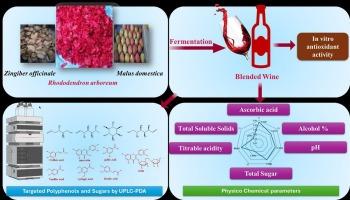发酵诱导了杜鹃花混合酒的理化性质、抗氧化活性、总糖和综合多酚谱的变化
IF 9.8
1区 农林科学
Q1 CHEMISTRY, APPLIED
引用次数: 0
摘要
本研究评估了七种实验葡萄酒配方的感官、物理化学和功能属性,这些配方包括苹果汁、生姜、蜂蜜或蔗糖,以及不同水平的杜鹃花汁。感官评分显示,添加杜鹃花的混合物在颜色、香气和甜味方面都有显著改善,处理T7(苹果+蜂蜜+生姜+树木樨)的总体可接受度最高。理化分析表明,可滴定酸度(0.19-0.51 %)、酒精(9.50-11.97 %)和抗坏血酸(4.76-8.53 mg/100 mL)的变化受底物组成和甜味剂类型的影响。加入木参可显著提高总酚含量(高达19.78 mg GAE/mL)和类黄酮含量(25.84 mg QE/mL)以及槲皮素和咖啡酸等目标化合物的含量。抗氧化试验也证实了优越的自由基清除活性。多变量分析表明,多酚含量与抗氧化性能之间存在很强的相关性。总体而言,木香的添加改善了感官吸引力和功能特性,支持其在功能酒开发中的潜力。本文章由计算机程序翻译,如有差异,请以英文原文为准。

Fermentation induced changes in physicochemical properties, antioxidant activity, total sugars, and comprehensive polyphenolic profiles of the Rhododendron-infused wine blends
This study evaluated the sensory, physicochemical, and functional attributes of seven experimental wine formulations incorporating apple juice, ginger, honey or sucrose, and varying levels of Rhododendron arboreum flower juice. Sensory scores revealed significant improvements in color, aroma and sweetness in rhododendron-enriched blends, with Treatment T7 (apple + honey + ginger + R. arboreum) achieving the highest overall acceptability. Physicochemical analyses showed variations in titratable acidity (0.19–0.51 %), alcohol (9.50–11.97 %), and ascorbic acid (4.76–8.53 mg/100 mL), influenced by substrate composition and sweetener type. Inclusion of R. arboreum substantially enhanced total phenolic (up to 19.78 mg GAE/mL) and flavonoid levels (25.84 mg QE/mL) alongside targeted compounds such as quercetin and caffeic acid. Antioxidant assays also confirmed superior radical scavenging activity. Multivariate analyses highlighted strong correlations between polyphenolic content and antioxidant performance. Overall, R. arboreum addition improved both sensory appeal and functional properties, supporting its potential in functional wine development.
求助全文
通过发布文献求助,成功后即可免费获取论文全文。
去求助
来源期刊

Food Chemistry
工程技术-食品科技
CiteScore
16.30
自引率
10.20%
发文量
3130
审稿时长
122 days
期刊介绍:
Food Chemistry publishes original research papers dealing with the advancement of the chemistry and biochemistry of foods or the analytical methods/ approach used. All papers should focus on the novelty of the research carried out.
 求助内容:
求助内容: 应助结果提醒方式:
应助结果提醒方式:


